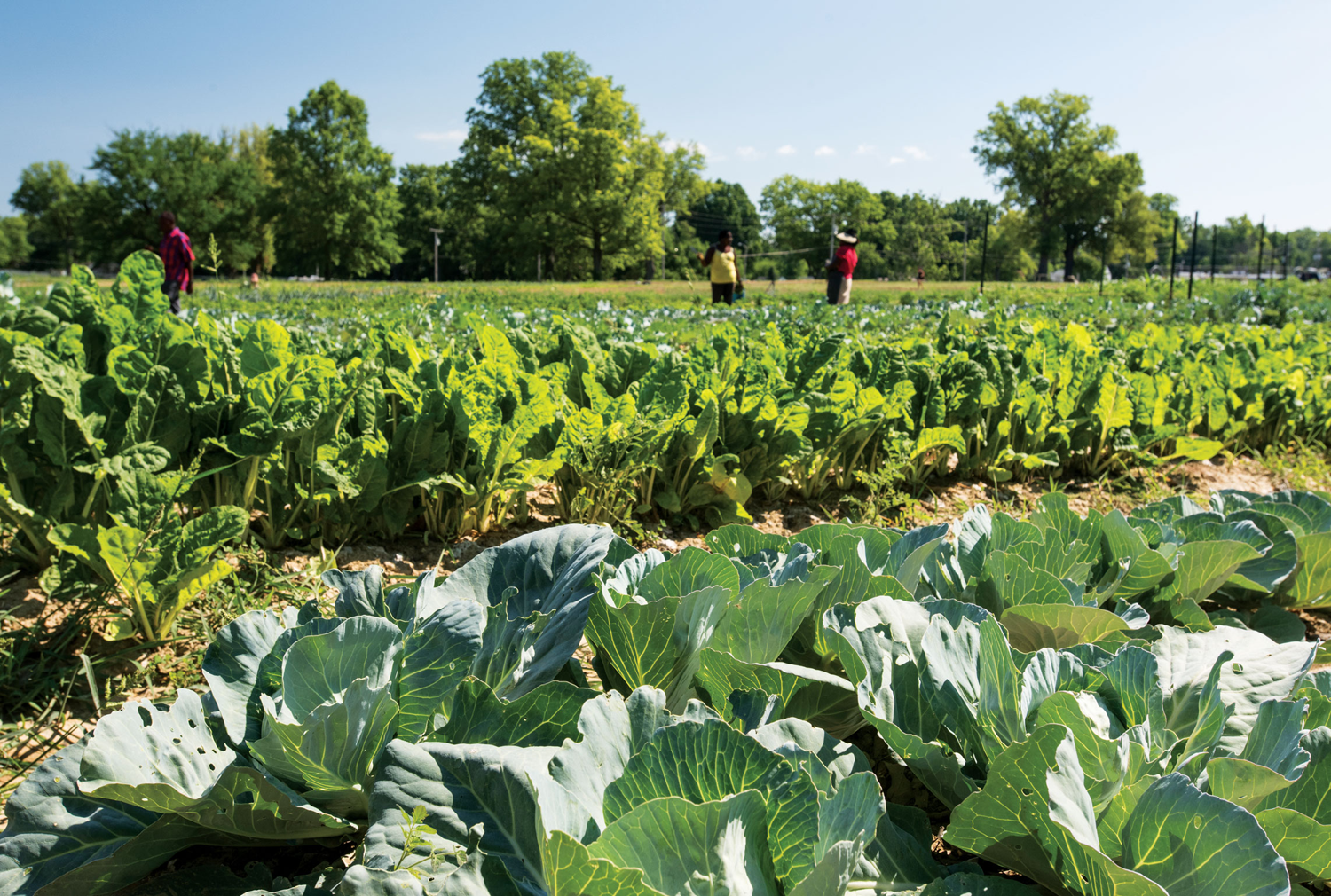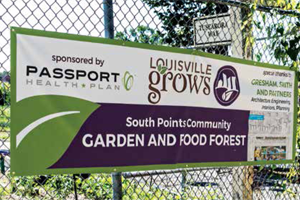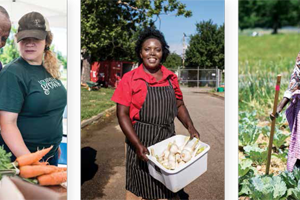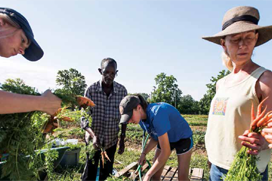Good in the Agrihood
In her cramped two-bedroom apartment in south central Louisville, Rwandan refugee Jaqueline, 47, shares a home with her younger brother, his wife and her infant nephew. Beside a queen-size bed in each bedroom is a chest freezer. Lifting the lid, she smiled to show off a deep freezer stuffed with Kroger bags. Each bag was crammed with frozen leaves trimmed from sweet potato, amaranth and eggplant plants.
“Without food, people cannot have life,” she said of that homegrown hoard she simmers alongside beans, corn and squash on a two-burner electric stove in her tiny kitchen. “Everybody likes this country because our old life was very hard.” Once hungry, she added, you always feel safest when you have stockpiles of food laid by.
Jacueline is among some 45 African refugee families who farm for their own sustenance and income at Hope Community Farm, on land occupied for more than a half century by Louisville’s largest public housing complex in the Iroquois neighborhood. In addition to feeding themselves and their families, they sell their produce via weekly shares to some 40 local families. Hope Farm is a project of the nonprofit Louisville Grows and spear headed by Whitney Sewell, Director of Urban Agriculture.
In its second year, the growth of this new “agri-hood,” or a neighborhood with a farm at its center, has rise to the healing of refugees, better meals eaten by elementary school students, local gardeners, a chance for young farmers to till the soil and the birth of a multi-cultural farmers market outside the budget-conscious supermarket on the farm’s perimeter.
Asked about her life before arriving in the United States in 2006, Jacueline shared the barest of details. She was born in a refugee camp in Burundi. She spent 30 years in a refugee camp in Rwanda, where her children were killed during the Rwandan genocide in the early 1990s. Asked for more detail, Jacueline shook her head. It’s common that the refugees who cultivate their crops at the new Hope Community Farm deflect queries about their violent past, said Sewell. “I tell people to watch `Hotel Rwanda,’ Sewell said of advice she gives farm visitors. “That way they can understand what has happened to these refugees.”
It was incredible to see such a large green space in an urban area sitting vacant.
The new Americans do poke fun. Sewell has been asked, for example, how many cows are in her dowry. Otherwise the refugees “can be pretty aloof,” Sewell said. “It’s just their communication style.”
Completed in the early 1950s, the Iroquois Homes cost $9 million (or $83 million in today’s dollars). Built to provide low-income housing in 854 apartments, over the next half century the community became so violent that gunshots were a daily occurrence. Eventually the decision was made to tear it down and demolition of the tan, barracks-style housing was completed in 2012.
Three years later, the barren land was nothing but sawgrass and purslane surrounded by a chain link fence. The land behind Hazelwood Elementary School was quiet.
Poverty and its consequences, however, endure. The average life expectancy in the neighborhood is about 70 years, 11 years behind the norm in eastern Jefferson County, according to the city’s 2014 Health Equity Report. The unemployment rate runs 20% and half of south central Louisville children live in poverty. The area is also considered a food desert, where less than 10% of food stores sell what is considered healthy food, according to an analysis by KentuckyOne Health.
Around 2014, immigrants from war-torn Somalia and other African countries who had been settled in the Iroquois neighborhood noticed the 14 acres behind the Save-A-Lot grocery store on Taylor Boulevard. They were people from the Congo, Rwanda and neighboring lands with a lifetime of experience growing food. That vacant ground sparked dreams of growing food again, said Valerie Magnuson, the former director of the Louisville Grows.
“It was incredible to see such a large green space in an urban area sitting vacant,” Magnuson said of the acreage lined by towering oak trees within earshot of the Watterson Expressway.
The refugees come together to worship and share in their new farming collective business at Gate of Hope Ministries, a nearby Christian church and nonprofit social services agency.
Field manager Fabrice speaks Kinyarwanda, a common tongue among others spoken by the refugees. He helps oversee 10 farmers who receive monthly stipends for working 10 hours a week. That money comes from sales of weekly produce shares to community residents.
When the immigrants first began farming the land, Fabrice noticed they planted vegetables too close together. “When they were trying to grow crops in a refugee camp, they had little water and little space,” Fabrice said.
Now in the second farming year, the land has developed many uses. Since mosquitos were a problem last summer, Louisville Grows saw a need for more predators like birds, frogs, snakes and bats. Bat boxes and birdhouses hang on the grounds. The northeast corner of the property is no longer mowed; instead, cattails are growing in that natural wetland where it is hoped frogs and snakes will also thrive. Two beehives last year have grown to 12 hives near that emerging wetland.
On Hazelwood Avenue, the Food Literacy Project has built raised beds to continue its work with improving the health of local families and children through locally raised food.
Working with KentuckyOne Health with elementary school students at nearby Hazelwood Elementary since 2009, Food Literacy Project staff helped train nine out of 10 families to prepare a healthy recipe or eat vegetables they raised themselves, said executive director Carol Gundersen. Some four in 10 participating students report eating five servings of fruits and vegetables each day, double what they typically consumed before that work began.
Results like those “boost the community’s food IQ,” according to the Food Literacy Project, whose activities also include an afterschool club and family events, like last fall’s South Points Family Jam. That daylong festival on October 15 featured hay rides, cider pressing, health screenings and more at the corner of Hazelwood and Bicknell Avenue.
At a family breakfast event on June 10, Gundersen said, “We had 50 or so folks, mostly from the neighborhood come out and see what is happening. We had the opportunity for them to make farm fresh omelets using some vegetables from the farm.”
Long before Iroquois Farm became a reality, the Food Literacy Project has been doing classroom work at Hazelwood Elementary. As those efforts transform into growing areas behind the school, she said, adding “This is a really beautiful evolution of a partnership.”
There are three raised beds, the very beginning of a teaching garden set in the context of commercial vegetable fields. Both growing areas are outdoor classrooms, she added.
“Our hope is for students at Hazelwood to participate in a field to fork program at the farm,” she said. “We hope it will be a resource for other schools and community-based organizations in that neighborhood for long term projects.”
To come is a shade pavilion and teaching kitchen much like the Food Literacy Project has at Oxmoor Farm, a gathering space that is shaded and a place to cook.
“That is the fork in field to fork,” Gundersen said. “There is a lot you can do with a butane burner but having a proper space and picnic tables and running water is so critical. We are excited. It just feels like a very natural next step for us. We’ve been working with Hazelwood for a long time. It just feels like there is a lot of synergy there.”
A big part of cultivating the ground has been filling four rubble dumpsters to the brim with broken sidewalk, cracked clay pipe, rusted rebar and debris from the soil.
“By hand, every day, as we turn over the land to plant seeds in the ground, we are also pulling out the rubble. It is kind of the shadow of the people who lived here previously.
We are growing food, transforming this land that used to be vacant into something productive.
It is a literal heavy weight that we carry out of here by hand,” Sewell said. “We are carrying it off to give new life to this land. The physical movement and food they are growing is nourishing to their bodies, or the families who get food weekly. When people come to the farm, it is not just new Americans doing this work. It is people coming to the farmers market on Sundays. They are neighborhood residents farming in their community plots. It is the children from the Food Literacy Project.”
On one side of Tuscarora Way, a housing project street that still runs through the farm property, Louisville Grows leased seven acres from the Louisville Metro Housing Authority. On the other side of that crumbling street, the Housing Authority and KentuckyOne Health leased another eight to farmer Ivor Chodkowski and his apprentice, Andrew Hockenberry.
“This project uses urban agriculture to rejuvenate a large vacant property into a productive, vibrant neighborhood amenity and to reconnect children and families with fresh, local food,” said Alice Bridges, the former leader of the project on behalf of KentuckyOne Health. A Minnesota hospital that cultivated its front lawn with crops to feed patients and staff in the cafeteria helped inspire the Hope Farm, she added.
While Bridges has moved on and KentuckyOne Health roils through a budgetary crisis that has seen it shed hospital properties like University Hospital, the hospital chain still operates St. Mary and Elizabeth Hospital nearby. The goal of a “farm-to-hospital” concept continues. This year, eight acres are being farmed for this for the first time. Funds to pay farmer Andrew Hockenberry derive from a $100,000 grant to KentuckyOne Health from the Jewish Heritage Fund for Excellence, Bridges said.
About Hockenberry, Sewell said, “Dude gets a salary. When you have to hustle for your paycheck in farming, the risk is so great. Your crop could fail. Until it sells, you will not get the money out. He can grow the food and get paid.” On an 85° morning in June, Hockenberry scooped handfuls of clay-heavy soil around a drooping sweet potato slip, one of 1,500 tender shoots being planted with a team of eight high school students employed by the Community Agriculture Project, a summer jobs program financed by the city.
Unlike most young farmers, Hockenberry, 25, enjoys the luxury of a salary from KentuckyOne for this first growing season. Gone is the chance to sell those sweet potatoes, squash, beans and other crops to the hospital chain during this first growing season. That’s because a packing shed required by federal law for required cleaning and handling of produce will not be constructed in time. As a result, Hockenberry and his assistant Amara McCarthy will find other ways to sell what they grow.
One idea is for consumers to purchase boxes of produce. Crops like herbs, squash, cucumbers, sweet potatoes and beans are also bound to wholesale purveyors like Creation Gardens, restaurants and prepared food producers like Grasshoppers. “We are growing food, transforming this land that used to be vacant into something productive, said Hockenberry. “The opportunity to farm on my own is huge.”
“It is a trial and repurposing of urban space,” farmer Amara McCarthy said of her work with Hockenberry to grow food on compacted soil once occupied by a housing project. “We knew this project was going to be a little tricky.”
On June 1, the Taylor Boulevard Save-A-Lot posted a photo on the store’s Instagram account. “Just picked! Lettuce, sugar snap peas and collard greens! These are grown right behind the store! Now that’s local,” the store announced.
Those early crops mark the latest investment by this family- owned, wallet-friendly food outlet in greening and feeding the neighborhood in partnership with the new farm behind the store.
The idea of an Iroquois Farm behind the grocery store first presented itself as an economic opportunity, said store co-owner Jenny Kute. The store’s produce section generates at least five garbage cans weekly of wilted vegetables and fruits that needs composting. The opportunity to compost directly behind the store saved money. Selling seeds and produce grown nearby broadened the store’s budget- conscious customer base.
“We get different shoppers than we normally draw,” Kute said. “It is good for us.”
On Sundays, you will find that spirit reflected in the parking lot, during the second year of the South Points Farmers Market from around 10am to 2pm. That’s when portable tent canopies pop up on the pavement at 4148 Taylor Blvd.
On any Sunday during the growing season, you might find Hope Farm growers from the Congo, Rwanda or Senegal selling squash, greens, eggplant and corn.
You will also see vegetables from Latin America that are unfamiliar to a typical Kentucky grocery shopper. Nelson Escobar sells four-ounce bunches of papalo, the succulent leaves from a bush that echo the taste of cilantro. He also sells chipilin, a leafy green used in Guatemala to stuff tamales and flavor soups. For a decade, Escobar has been growing native greens, squash blossoms and purple potatoes on the land of La Minga, a farming collective on Route 42 in Goshen. Until Save- A-Lot became host to the South Points Farmers’ Market, Escobar said he spent 10 years searching for customers who would appreciate his specialty vegetable crops.
“This is the farmers’ market where the brown people shop,” said Escobar, adding he was astonished and overjoyed to sell 10 bunches of papalo recently to a Mexican immigrant. “For years, I have been looking for my Latin American customers. Now I have found them.”
On any given day, half of the customers purchase with food stamps at the South Points Farmers’ Market. Instead of taking away from store transactions on market days, the business local farmers do outside the Save-A-Lot also bring business inside, Kute said.
“Sunday is our biggest produce sales day,” she said.
South Points Food Collaborative — by the numbers
14 acres – total farm size on land occupied by the Iroquois Homes from 1951 to 2012
25 – Iroquois neighborhood families growing their own produce in Hope Farm community garden on site 45 – refugee families growing their own food in community garden plots
12 – beehives; 3 – greenhouses
40 – Louisville households who subscribe to weekly shares of produce sold by the collective of 10 refugee farmers
60,000 pounds – amount of food grown in 2016, the first growing season
320,000 pounds – the weight of broken concrete, steel, tile, pipe and other cast-off rubble excavated from farmed soil to date.
1951 – year Iroquois Homes was built for white, low-income residents (later desegregated)
2012 – year the last of the Iroquois Homes was demolished. Police report drop in neighborhood burglaries, assaults and robberies.
There are multiple points of participation:
Volunteer: Food Literacy Project, foodliteracyproject.org, Gate of Hope Ministries, http://gateofhope2.org/ or Louisville Grows, louisvillegrows.org
Shop on Sundays at the South Points Farmers’ Market outside the Save-A-Lot on Taylor Boulevard. South Points Farmers’ Market: Facebook.com/spfmky/. @spfmky on Instagram
Sign up for a weekly share of veggies from the Hope Farm refugee cooperative by emailing whitney@louisvillegrows.org
Community members can sign up for their own garden plots by emailing whitney@louisvillegrows.org











